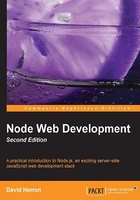
Installing from source on POSIX-like systems
Installing the pre-packaged Node distributions is currently the preferred installation method. However, installing Node from source is desirable in a few situations:
- It could let you optimize the compiler settings as desired
- It could let you cross-compile, say for an embedded ARM system
- You might need to keep multiple Node builds for testing
- You might be working on Node itself
Now that you have the high-level view, let's get our hands dirty mucking around in some build scripts. The general process follows the usual configure, make, and make install routine that you may already have performed with other open source software packages. If not, don't worry, we'll guide you through the process.
The official installation instructions are in the Node wiki at https://github.com/joyent/node/wiki/Installation.
Installing prerequisites
As noted a minute ago, there are three prerequisites, a C compiler, Python, and the OpenSSL libraries. The Node installation process checks for their presence and will fail if the C compiler or Python is not present. The specific method of installing these is dependent on your operating system.
These commands will check for their presence:
$ cc --version i686-apple-darwin10-gcc-4.2.1 (GCC) 4.2.1 (Apple Inc. build 5666) (dot 3) Copyright (C) 2007 Free Software Foundation, Inc. This is free software; see the source for copying conditions. There is NO warranty; not even for MERCHANTABILITY or FITNESS FOR A PARTICULAR PURPOSE. $ python Python 2.6.6 (r266:84292, Feb 15 2011, 01:35:25) [GCC 4.2.1 (Apple Inc. build 5664)] on darwin Type "help", "copyright", "credits" or "license" for more information. >>>